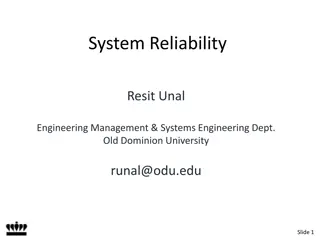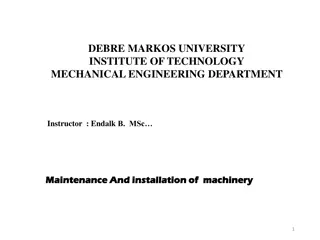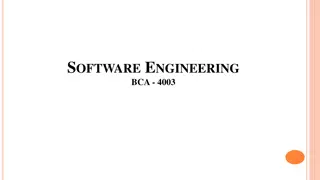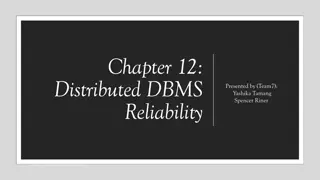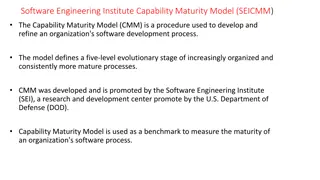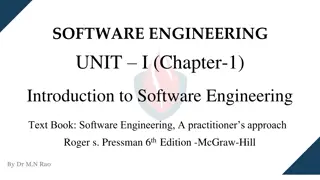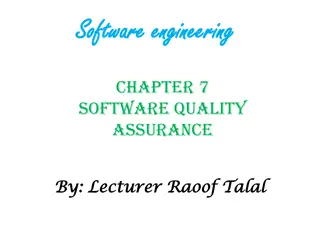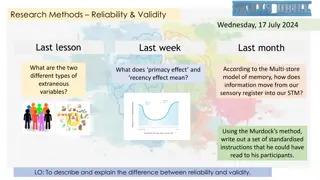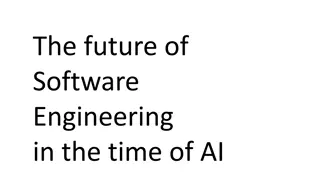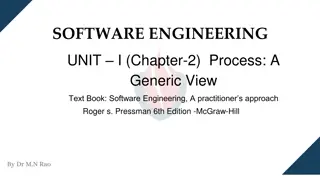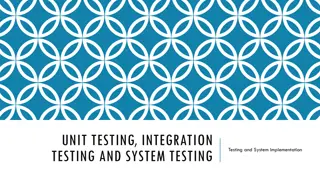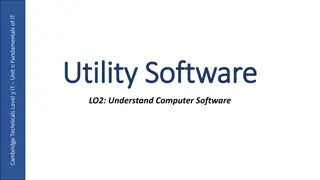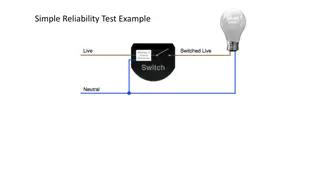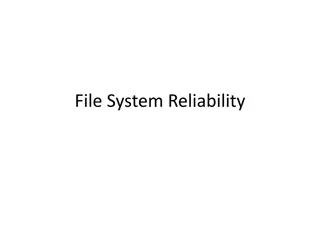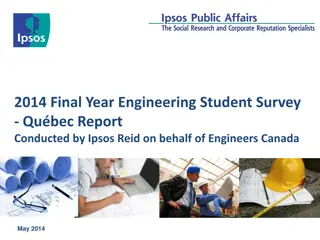Understanding Software Reliability Engineering Concepts
Explore the key topics of availability, reliability requirements, fault-tolerant architectures, and programming for reliability in software engineering. Learn about different types of faults, errors, and failures, along with strategies for fault management and avoidance to enhance software dependability in critical applications.
Download Presentation

Please find below an Image/Link to download the presentation.
The content on the website is provided AS IS for your information and personal use only. It may not be sold, licensed, or shared on other websites without obtaining consent from the author. Download presentation by click this link. If you encounter any issues during the download, it is possible that the publisher has removed the file from their server.
E N D
Presentation Transcript
Chapter 11 Reliability Engineering 30/10/2014 Chapter 11 Reliability Engineering 1
Topics covered Availability and reliability Reliability requirements Fault-tolerant architectures Programming for reliability Reliability measurement 30/10/2014 Chapter 11 Reliability Engineering 2
Software reliability In general, software customers expect all software to be dependable. However, for non-critical applications, they may be willing to accept some system failures. Some applications (critical systems) have very high reliability requirements and special software engineering techniques may be used to achieve this. Medical systems Telecommunications and power systems Aerospace systems 30/10/2014 Chapter 11 Reliability Engineering 3
Faults, errors and failures Term Description Human error or mistake Human behavior that results in the introduction of faults into a system. For example, in the wilderness weather system, a programmer might decide that the way to compute the time for the next transmission is to add 1 hour to the current time. This works except when the transmission time is between 23.00 and midnight (midnight is 00.00 in the 24-hour clock). A characteristic of a software system that can lead to a system error. The fault is the inclusion of the code to add 1 hour to the time of the last transmission, without a check if the time is greater than or equal to 23.00. An erroneous system state that can lead to system behavior that is unexpected by system users. The value of transmission time is set incorrectly (to 24.XX rather than 00.XX) when the faulty code is executed. An event that occurs at some point in time when the system does not deliver a service as expected by its users. No weather data is transmitted because the time is invalid. System fault System error System failure 30/10/2014 Chapter 11 Reliability Engineering 4
Faults and failures Failures are a usually a result of system errors that are derived from faults in the system However, faults do not necessarily result in system errors The erroneous system state resulting from the fault may be transient and corrected before an error arises. The faulty code may never be executed. Errors do not necessarily lead to system failures The error can be corrected by built-in error detection and recovery The failure can be protected against by built-in protection facilities. These may, for example, protect system resources from system errors 30/10/2014 Chapter 11 Reliability Engineering 5
Fault management Fault avoidance The system is developed in such a way that human error is avoided and thus system faults are minimised. The development process is organised so that faults in the system are detected and repaired before delivery to the customer. Fault detection Verification and validation techniques are used to discover and remove faults in a system before it is deployed. Fault tolerance The system is designed so that faults in the delivered software do not result in system failure. 30/10/2014 Chapter 11 Reliability Engineering 6
Reliability achievement Fault avoidance Development technique are used that either minimise the possibility of mistakes or trap mistakes before they result in the introduction of system faults. Fault detection and removal Verification and validation techniques are used that increase the probability of detecting and correcting errors before the system goes into service are used. Fault tolerance Run-time techniques are used to ensure that system faults do not result in system errors and/or that system errors do not lead to system failures. 30/10/2014 Chapter 11 Reliability Engineering 7
The increasing costs of residual fault removal 30/10/2014 Chapter 11 Reliability Engineering 8
Availability and reliability 30/10/2014 Chapter 11 Reliability Engineering 9
Availability and reliability Reliability The probability of failure-free system operation over a specified time in a given environment for a given purpose Availability The probability that a system, at a point in time, will be operational and able to deliver the requested services Both of these attributes can be expressed quantitatively e.g. availability of 0.999 means that the system is up and running for 99.9% of the time. 30/10/2014 Chapter 11 Reliability Engineering 10
Reliability and specifications Reliability can only be defined formally with respect to a system specification i.e. a failure is a deviation from a specification. However, many specifications are incomplete or incorrect hence, a system that conforms to its specification may fail from the perspective of system users. Furthermore, users don t read specifications so don t know how the system is supposed to behave. Therefore perceived reliability is more important in practice. 30/10/2014 Chapter 11 Reliability Engineering 11
Perceptions of reliability The formal definition of reliability does not always reflect the user s perception of a system s reliability The assumptions that are made about the environment where a system will be used may be incorrect Usage of a system in an office environment is likely to be quite different from usage of the same system in a university environment The consequences of system failures affects the perception of reliability Unreliable windscreen wipers in a car may be irrelevant in a dry climate Failures that have serious consequences (such as an engine breakdown in a car) are given greater weight by users than failures that are inconvenient 30/10/2014 Chapter 11 Reliability Engineering 12
A system as an input/output mapping 30/10/2014 Chapter 11 Reliability Engineering 13
Availability perception Availability is usually expressed as a percentage of the time that the system is available to deliver services e.g. 99.95%. However, this does not take into account two factors: The number of users affected by the service outage. Loss of service in the middle of the night is less important for many systems than loss of service during peak usage periods. The length of the outage. The longer the outage, the more the disruption. Several short outages are less likely to be disruptive than 1 long outage. Long repair times are a particular problem. 30/10/2014 Chapter 11 Reliability Engineering 14
Software usage patterns 30/10/2014 Chapter 11 Reliability Engineering 15
Reliability in use Removing X% of the faults in a system will not necessarily improve the reliability by X%. Program defects may be in rarely executed sections of the code so may never be encountered by users. Removing these does not affect the perceived reliability. Users adapt their behaviour to avoid system features that may fail for them. A program with known faults may therefore still be perceived as reliable by its users. 30/10/2014 Chapter 11 Reliability Engineering 16
Reliability requirements 30/10/2014 Chapter 11 Reliability Engineering 17
Warsaw plane crash, 1993 The plane landed asymmetrically, right gear first, left gear 9 sec later. Computer logic prevented the activation of both ground spoilers and thrust reversers until a minimum compression load of at least 6.3 tons was sensed on each main landing gear strut, thus preventing the crew from achieving any braking action by the two systems before this condition was met. To ensure that the thrust-reverse system and the spoilers are only activated in a landing situation, the software has to be sure the airplane is on the ground even if the systems are selected mid-air. The spoilers are only activated if at least one of the following two conditions is true: 30/10/2014 Chapter 11 Reliability Engineering 18
Warsaw plane crash, 1993 there must be weight of at least 6.3 tons on each main landing gear strut the wheels of the plane must be turning faster than 72 knots (133 km/h). The thrust reversers are only activated if the first condition is true. There is no way for the pilots to override the software decision and activate either system manually. In the case of the Warsaw accident neither of the first two conditions was fulfilled, so the most effective braking system was not activated. 30/10/2014 Chapter 11 Reliability Engineering 19
System reliability requirements Functional reliability requirements define system and software functions that avoid, detect or tolerate faults in the software and so ensure that these faults do not lead to system failure. Software reliability requirements may also be included to cope with hardware failure or operator error. Reliability is a measurable system attribute so non- functional reliability requirements may be specified quantitatively. These define the number of failures that are acceptable during normal use of the system or the time in which the system must be available. 30/10/2014 Chapter 11 Reliability Engineering 20
Reliability metrics Reliability metrics are units of measurement of system reliability. System reliability is measured by counting the number of operational failures and, where appropriate, relating these to the demands made on the system and the time that the system has been operational. A long-term measurement programme is required to assess the reliability of critical systems. Metrics Probability of failure on demand Rate of occurrence of failures/Mean time to failure Availability 30/10/2014 Chapter 11 Reliability Engineering 21
Probability of failure on demand (POFOD) This is the probability that the system will fail when a service request is made. Useful when demands for service are intermittent and relatively infrequent. Appropriate for protection systems where services are demanded occasionally and where there are serious consequence if the service is not delivered. Relevant for many safety-critical systems with exception management components Emergency shutdown system in a chemical plant. 30/10/2014 Chapter 11 Reliability Engineering 22
Rate of fault occurrence (ROCOF) Reflects the rate of occurrence of failure in the system. ROCOF of 0.002 means 2 failures are likely in each 1000 operational time units e.g. 2 failures per 1000 hours of operation. Relevant for systems where the system has to process a large number of similar requests in a short time Credit card processing system, airline booking system. Reciprocal of ROCOF is Mean time to Failure (MTTF) Relevant for systems with long transactions i.e. where system processing takes a long time (e.g. CAD systems). MTTF should be longer than expected transaction length. 30/10/2014 Chapter 11 Reliability Engineering 23
Availability Measure of the fraction of the time that the system is available for use. Takes repair and restart time into account Availability of 0.998 means software is available for 998 out of 1000 time units. Relevant for non-stop, continuously running systems telephone switching systems, railway signalling systems. 30/10/2014 Chapter 11 Reliability Engineering 24
Availability specification Availability Explanation 0.9 The system is available for 90% of the time. This means that, in a 24-hour period (1,440 minutes), the system will be unavailable for 144 minutes. 0.99 In a 24-hour period, the system is unavailable for 14.4 minutes. 0.999 The system is unavailable for 84 seconds in a 24-hour period. 0.9999 The system is unavailable for 8.4 seconds in a 24-hour period. Roughly, one minute per week. 30/10/2014 Chapter 11 Reliability Engineering 25
Non-functional reliability requirements Non-functional reliability requirements are specifications of the required reliability and availability of a system using one of the reliability metrics (POFOD, ROCOF or AVAIL). Quantitative reliability and availability specification has been used for many years in safety-critical systems but is uncommon for business critical systems. However, asmore and more companiesdemand 24/7 service from their systems, it makes sense for them to be precise about their reliability and availability expectations. 30/10/2014 Chapter 11 Reliability Engineering 26
Benefits of reliability specification The process of deciding the required level of the reliability helps to clarify what stakeholders really need. It provides a basis for assessing when to stop testing a system. You stop when the system has reached its required reliability level. It is a means of assessing different design strategies intended to improve the reliability of a system. If a regulator has to approve a system (e.g. all systems that are critical to flight safety on an aircraft are regulated), then evidence that a required reliability target has been met is important for system certification. 30/10/2014 Chapter 11 Reliability Engineering 27
Specifying reliability requirements Specify the availability and reliability requirements for different types of failure. There should be a lower probability of high-cost failures than failures that don t have serious consequences. Specify the availability and reliability requirements for different types of system service. Critical system services should have the highest reliability but you may be willing to tolerate more failures in less critical services. Think about whether a high level of reliability is really required. Other mechanisms can be used to provide reliable system service. 30/10/2014 Chapter 11 Reliability Engineering 28
ATM reliability specification Key concerns To ensure that their ATMs carry out customer services as requested and that they properly record customer transactions in the account database. To ensure that these ATM systems are available for use when required. Database transaction mechanisms may be used to correct transaction problems so a low-level of ATM reliability is all that is required Availability, in this case, is more important than reliability 30/10/2014 Chapter 11 Reliability Engineering 29
ATM availability specification System services The customer account database service; The individual services provided by an ATM such as withdraw cash , provide account information , etc. The database service is critical as failure of this service means that all of the ATMs in the network are out of action. You should specify this to have a high level of availability. Database availability should be around 0.9999, between 7 am and 11pm. This corresponds to a downtime of less than 1 minute per week. 30/10/2014 Chapter 11 Reliability Engineering 30
ATM availability specification For an individual ATM, the key reliability issues depends on mechanical reliability and the fact that it can run out of cash. A lower level of software availability for the ATM software is acceptable. The overall availability of the ATM software might therefore be specified as 0.999, which means that a machine might be unavailable for between 1 and 2 minutes each day. 30/10/2014 Chapter 11 Reliability Engineering 31
Insulin pump reliability specification Probability of failure (POFOD) is the most appropriate metric. Transient failures that can be repaired by user actions such as recalibration of the machine. A relatively low value of POFOD is acceptable (say 0.002) one failure may occur in every 500 demands. Permanent failures require the software to be re-installed by the manufacturer. This should occur no more than once per year. POFOD for this situation should be less than 0.00002. 30/10/2014 Chapter 11 Reliability Engineering 32
Functional reliability requirements Checking requirements that identify checks to ensure that incorrect data is detected before it leads to a failure. Recovery requirements that are geared to help the system recover after a failure has occurred. Redundancy requirements that specify redundant features of the system to be included. Process requirements for reliability which specify the development process to be used may also be included. 30/10/2014 Chapter 11 Reliability Engineering 33
Examples of functional reliability requirements RR1: the system shall check that all operator inputs fall within this pre-defined range. (Checking) RR2: Copies of the patient database shall be maintained on two separate servers that are not housed in the same building. (Recovery, redundancy) RR3: N-version programming shall be used to implement the braking control system. (Redundancy) RR4: The system must be implemented in a safe subset of Ada and checked using static analysis. (Process) A pre-defined range for all operator inputs shall be defined and 30/10/2014 Chapter 11 Reliability Engineering 34
Fault-tolerant architectures 30/10/2014 Chapter 11 Reliability Engineering 35
Fault tolerance In critical situations, software systems must be fault tolerant. Fault tolerance is required where there are high availability requirements or where system failure costs are very high. Fault tolerance means that the system can continue in operation in spite of software failure. Even if the system has been proved to conform to its specification, it must also be fault tolerant as there may be specification errors or the validation may be incorrect. 30/10/2014 Chapter 11 Reliability Engineering 36
Fault-tolerant system architectures Fault-tolerant systems architectures are used in situations where fault tolerance is essential. These architectures are generally all based on redundancy and diversity. Examples of situations where dependable architectures are used: Flight control systems, where system failure could threaten the safety of passengers Reactor systems where failure of a control system could lead to a chemical or nuclear emergency Telecommunication systems, where there is a need for 24/7 availability. 30/10/2014 Chapter 11 Reliability Engineering 37
Protection systems A specialized system that is associated with some other control system, which can take emergency action if a failure occurs. System to stop a train if it passes a red light System to shut down a reactor if temperature/pressure are too high Protection systems independently monitor the controlled system and the environment. If a problem is detected, it issues commands to take emergency action to shut down the system and avoid a catastrophe. 30/10/2014 Chapter 11 Reliability Engineering 38
Protection system architecture 30/10/2014 Chapter 11 Reliability Engineering 39
Protection system functionality Protection systems are redundant because they include monitoring and control capabilities that replicate those in the control software. Protection systems should be diverse and use different technology from the control software. They are simpler than the control system so more effort can be expended in validation and dependability assurance. Aim is to ensure that there is a low probability of failure on demand for the protection system. 30/10/2014 Chapter 11 Reliability Engineering 40
Self-monitoring architectures Multi-channel architectures where the system monitors its own operations and takes action if inconsistencies are detected. The same computation is carried out on each channel and the results are compared. If the results are identical and are produced at the same time, then it is assumed that the system is operating correctly. If the results are different, then a failure is assumed and a failure exception is raised. 30/10/2014 Chapter 11 Reliability Engineering 41
Self-monitoring architecture 30/10/2014 Chapter 11 Reliability Engineering 42
Self-monitoring systems Hardware in each channel has to be diverse so that common mode hardware failure will not lead to each channel producing the same results. Software in each channel must also be diverse, otherwise the same software error would affect each channel. If high-availability is required, you may use several self- checking systems in parallel. This is the approach used in the Airbus family of aircraft for their flight control systems. 30/10/2014 Chapter 11 Reliability Engineering 43
Airbus flight control system architecture 30/10/2014 Chapter 11 Reliability Engineering 44
Airbus architecture discussion The Airbus FCS has 5 separate computers, any one of which can run the control software. Extensive use has been made of diversity Primary systems use a different processor from the secondary systems. Primary and secondary systems use chipsets from different manufacturers. Software in secondary systems is less complex than in primary system provides only critical functionality. Software in each channel is developed in different programming languages by different teams. Different programming languages used in primary and secondary systems. 30/10/2014 Chapter 11 Reliability Engineering 45
N-version programming Multiple versions of a software system carry out computations at the same time. There should be an odd number of computers involved, typically 3. The results are compared using a voting system and the majority result is taken to be the correct result. Approach derived from the notion of triple-modular redundancy, as used in hardware systems. 30/10/2014 Chapter 11 Reliability Engineering 46
Hardware fault tolerance Depends on triple-modular redundancy (TMR). There are three replicated identical components that receive the same input and whose outputs are compared. If one output is different, it is ignored and component failure is assumed. Based on most faults resulting from component failures rather than design faults and a low probability of simultaneous component failure. 30/10/2014 Chapter 11 Reliability Engineering 47
Triple modular redundancy 30/10/2014 Chapter 11 Reliability Engineering 48
N-version programming 30/10/2014 Chapter 11 Reliability Engineering 49
N-version programming The different system versions are designed and implemented by different teams. It is assumed that there is a low probability that they will make the same mistakes. The algorithms used should but may not be different. There is some empirical evidence that teams commonly misinterpret specifications in the same way and chose the same algorithms in their systems. 30/10/2014 Chapter 11 Reliability Engineering 50





